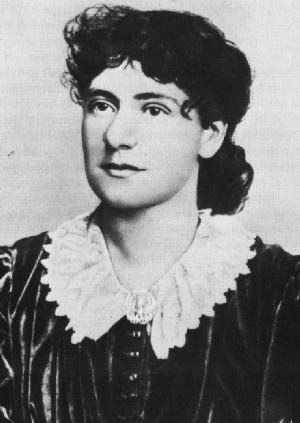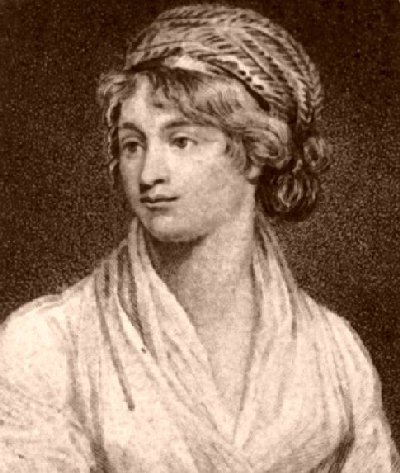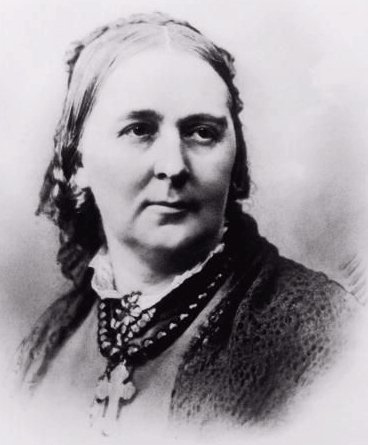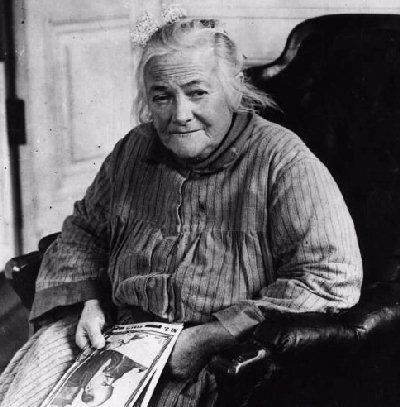 |
|||||
|
Biographies of Great Feminists
Wollstonecraft, Mary (1759-1797)Daughter of a handkerchief weaver, was born in Spitalfields, London in 1759. The family moved a great deal during Mary’s childhood and she lived for periods at Epping, Barking, Beverley, Hoxton, Walworth and Laugharne in Wales. In 1784, Mary Wollstonecraft opened a school in Newington Green, a small village close to Hackney, with her sister Eliza and a friend, Fanny Blood. Soon after arriving in Newington Green, Mary made friends with Richard Price, a minister at the local Dissenting Chapel. Price and his friend, Joseph Priestly, were the leaders of a group of men known as Rational Dissenters. Price had written several books including the very influential Review of the Principal Questions of Morals (1758) where he argued that individual conscience and reason should be used when making moral choices. Price also rejected the traditional Christian ideas of original sin and eternal punishment. As a result of these religious views, some Anglicans accused Rational Dissenters of being atheists. Although Mary was brought up as an Anglican, she soon began attending Richard Price’s chapel. Price held radical political views and had encountered a great deal of hostility when he supported the cause of American independence. At Price’s home Mary Wollstonecraft met other leading radicals including the publisher, Joseph Johnson. He was impressed by Mary’s ideas on education and commissioned her to write a book on the subject. In Thoughts on the Education of Girls, published in 1786, Mary attacked traditional teaching methods and suggested new topics that should be studied by girls. Two years later Wollstonecraft helped Johnson to found the journal Analytical Review.
In November, 1789, Richard Price preached a sermon praising the French Revolution. Price argued that British people, like the French, had the right to remove a bad king from the throne. Edmund Burke, was appalled by this sermon and wrote a reply called Reflections on the Revolution in France where he argued in favour of the inherited rights of the monarchy. Wollstonecraft was upset by Burke’s attack on her friend and she decided to defend him by writing a pamphlet A Vindication of the Rights of Man. In her pamphlet Wollstonecraft not only supported Price but also pointed out what she thought was wrong with society. This included the slave trade, the game laws and way that the poor were treated. The publication of A Vindication of the Rights of Man brought Wollstonecraft to the attention of other radical thinkers such as Tom Paine, John Cartwright, John Horne Tooke, William Godwin and William Blake. Wollstonecraft met several of these men including Godwin who was busily writing a book on Political Justice. In 1791 the first part of Tom Paine’s Rights of Man was published. This book created a burst of radical activity and although Paine was forced to flee the country, others were determined to carry on the struggle in England. Soon after Rights of Man appeared, two of Britain’s leading Rational Dissenters, Richard Price and Joseph Priestly, formed the Unitarian Society, an organisation that was to have a profound influence on religious and political ideas in Britain. The following year Mary Wollstonecraft published her most important book, Vindication of the Rights of Women. In the book Wollstonecraft attacked the educational restrictions that kept women in a state of “ignorance and slavish dependence.” She was especially critical of a society that encouraged women to be “docile and attentive to their looks to the exclusion of all else.” Wollstonecraft described marriage as “legal prostitution” and added that women “may be convenient slaves, but slavery will have its constant effect, degrading the master and the abject dependent.” The ideas in Wollstonecraft’s book were truly revolutionary and caused tremendous controversy. One critic described Wollstonecraft as a “hyena in petticoats.” Mary Wollstonecraft argued that to obtain social equality society must rid itself of the monarchy as well as the church and military hierarchies. Mary Wollstonecraft’s views even shocked fellow radicals. Whereas advocates of parliamentary reform such as Jeremy Bentham and John Cartwright had rejected the idea of female suffrage, Wollstonecraft argued that the rights of man and the rights of women were one and the same thing. In 1793 Edmund Burke led the attack on the radicals in Britain. He described the London Corresponding Society and the Unitarian Society as “loathsome insects that might, if they were allowed, grow into giant spiders as large as oxen.” King George III issued a proclamation against seditious writings and meetings, threatening serious punishments for those who refused to accept his authority. In June, 1793 Mary decided to move to France with the American writer, Gilbert Imlay. The following year, Mary gave birth to Fanny. After her relationship with Imlay came to an end she returned to London. Mary married William Godwin in March, 1797 and soon afterwards, a second daughter, Mary, was born. The baby was healthy but the placenta was retained in the womb. The doctor’s attempt to remove the placenta resulted in blood poisoning and Mary died on 10th September, 1797.
Taylor, Harriet (1856-1915)Harriet Taylor, the daughter of Thomas Hardy, a London surgeon, and his wife Harriet Hurst, was born on 8th October, 1807. At the age of eighteen she married John Taylor, a wealthy businessman from Islington. In the next few years Harriet had three children. John and Harriet Taylor both became active in the Unitarian Church and developed radical views on politics. They became friendly with William Fox, a leading Unitarian minister and early supporter of women’s rights. Harriet Taylor moved in radical circles and in 1830 she met the philosopher John Stuart Mill. Taylor was attracted to Mill, the first man she had met who treated her as an intellectual equal. Mill was impressed with Taylor and asked her to read and comment on the latest book he was working on. Harriet Taylor’s relationship with her husband began to deteriorate and in 1833 he agreed to a trial separation. Harriet moved to a house at Walton-on-Thames where John Start Mill visited her at weekends. Although Harriet Taylor and Mill claimed they were not having a sexual relationship, their behaviour scandalized their friends. As a result, the couple became socially isolated. Over the next few years Harriet Taylor and John Stuart Mill exchanged essays on issues such as marriage and women’s rights. Those essays that have survived reveal that Taylor held more radical views than Mill on these subjects. Taylor was attracted to the socialist philosophy that had been promoted by Robert Owen in books such as The Formation of Character (1813) and A New View of Society (1814). In her essays Taylor was especially critical of the degrading effect of women’s economic dependence on men. Taylor thought this situation could only be changed by the radical reform of all marriage laws. Although Mill shared Taylor’s belief in equal rights, he favoured laws that gave women equality rather than independence. Except for a few articles in the Unitarian journal Monthly Repository, Taylor published little of her own work during her lifetime. However, Taylor read and commented on all the material produced by John Stuart Mill. In his autobiography, Mill claimed that Harriet was the joint author of most of the books and articles that were published under his name. He added, “when two persons have their thoughts and speculations completely in common it is of little consequence in respect of the question of originality, which of them holds the pen.” In 1848 John Stuart Mill’s Principles of Political Economy was published. Mill planned to include details of the role that Taylor had played in the production of the book, but when John Taylor heard about this he objected and references to his wife were removed. However, in his autobiography, Mill pointed out that Principles of Political Economy was “a joint production with my wife.” John Taylor died of cancer on 3rd May, 1849. Still concerned about gossip and scandal, Harriet insisted that they wait two years before they got married. A few months after the wedding the Westminster Review published The Enfranchisement of Women. Although the article had been mainly written by Taylor, it appeared under John Stuart Mill’s name. The same happened with the publication of an article in the Morning Chronicle (28th August, 1851) where they advocated new laws to protect women from violent husbands. A letter written by Mill in 1854 suggests that Harriet was reluctant to be described as joint author of Mill’s books and articles. “I shall never be satisfied unless you allow our best book, the book which is to come, to have our two names on the title page. It ought to be so with everything I publish, for the better half of it all is yours.” John Stuart Mill had always favoured the secret ballot but Harriet disagreed and eventually changed her husband’s views on the subject. Taylor feared that people would vote in their own self-interest rather than for the good of the community. She believed that if people voted in public, the exposure of their selfishness would shame them in voting for the candidate who put forward policies that were in the interests of the majority. Harriet Taylor and John Stuart Mill both suffered from tuberculosis. While in France seeking treatment for this condition in November, 1858, Harriet died. Mill and Taylor had been working on a book The Subjection of Women at the time. Helen, Harriet Taylor’s daughter, now helped Mill to finish the book. The two worked closely together for the next fifteen years. In his autobiography Mill wrote that “Whoever, either now or hereafter, may think of me and my work I have done, must never forget that it is the product not of one intellect and conscience but of three, the least considerable of whom, and above all the least original, is the one whose name is attached to it.” As well as helping Mill with his books and articles, Helen Taylor was active in the women’s suffrage campaign. She was an original member of the Kensington Society that produced the first petition requesting votes for women. Helen also accompanied John Stuart Mill to the House of Commons on the day he attempted to add an amendment to the 1867 Reform Act that would have women the same political rights as men. However, the amendment was defeated by 196 votes to 73. Helen Taylor also took part in the agitation for women to be allowed to take part in local government and after the passing of the 1870 Education Act served as a member of the London School Board.
|
|
||||
|
|
|||||

Marx, Eleanor (Tussy) (1855-1898)Karl Marx’s youngest daughter. Tussy was a precocious youngster who showed an early interest in politics including writing to major political figures around the world as a child. Eleanor and her two sisters grew up with their father’s story-telling and immersed in literature. Tussy began a life-long love of books and theater. She would later translate several works of literature as well as become a stage actress. Once engaged to Prosper Lissagary, she met Edward Aveling in 1883 and they would live together in common law for the reminder of her life. They became members of the Democratic Federation led by Henry Hyndman in the early 1880s. Tussy wrote in the draft of the program that the needed change in society will be a revolution. "The two classes at present existing will be replaced by a single class consisting of the whole of the healthy and sane members of the community, possessing all the means of production and distribution in common...". The Democratic Federation, later renamed the Social Democratic Federation broke up in 1884 over personality problems and the issue of internationalism. The Avelings and William Morris formed the Socialist League which published a monthly paper called Commonweal. In this vehicle Tussy wrote several articles and reviews on women’s and other issues as well as a pamphlet entitled The Woman Question. In 1886 Tussy toured in the U.S. along with Wilhelm Liebknecht fundraising for the German Social Democratic Party and in support of the Haymarket affair. Along with continuing work translating literature and acting, she became very involved in organizing, writing, record-keeping and speaking for militant trade union such as the Gasworkers, and the Dockers Union and their struggles. In 1889 she was a delegate in Paris for the founding of the Second International. Later in her life, Tussy became very involved in organizing the part of her father’s papers left to her after the death of Engels, as well as continuing her own work. During a period of depression in 1889, she commit suicide at the age of 43.
Zetkin, Clara (1857-1933)A prominent figure in the German and international workers' movement, most notably in the struggles womens workers' movement. From 1895, a National Executive member of the German SPD, and on its left-wing; member of the Bookbinders Union in Stuttgart, and active in the Tailors and Seamstresses Union, becoming its provisional International Secretary in 1896, despite the fact that it was illegal for women to be members of trade unions in Germany at that time. As Secretary of the International Bureau of Socialist Women, Zetkin organised the Socialist Women's Conference in March 1915. Along with Alexandre Kollontai, Zetkin fought for unrestricted suffrage, and against the 'bourgeois feminist' position supporting the restriction of the vote by property or income. Zetkin and Rosa Luxemburg led the left-wing and waged a fierce struggle against revisionism as well as the center represented by Kautsky. During the War joined the Spartacists along with Luxemburg and Liebknecht. A founding member of the German Communist Party in 1918 along with comrades including Karl Liebknecht and Rosa Luxemburg. Became a delegate to the Reichstag from 1920; secretary of the International Women's Secretariat and member of the Executive Committee of the Communist International from 1921, but lived in Russia from 1924 until her death in 1933.
|
|||||
 |
|
 |
|||


